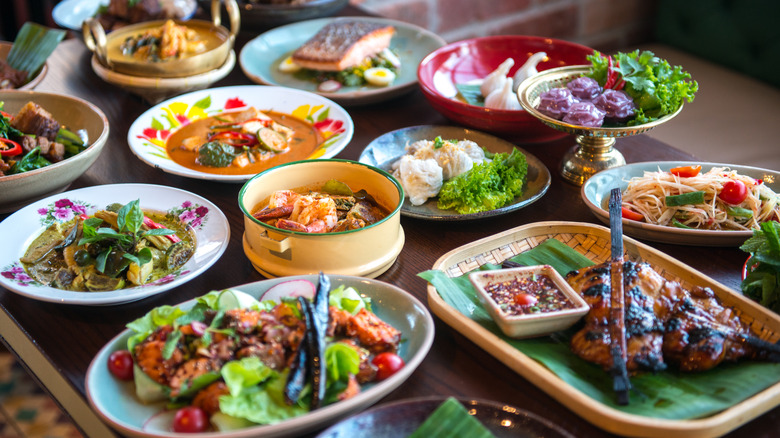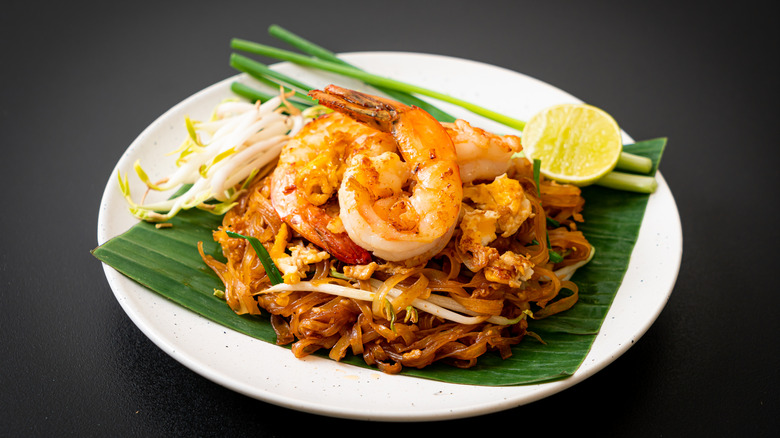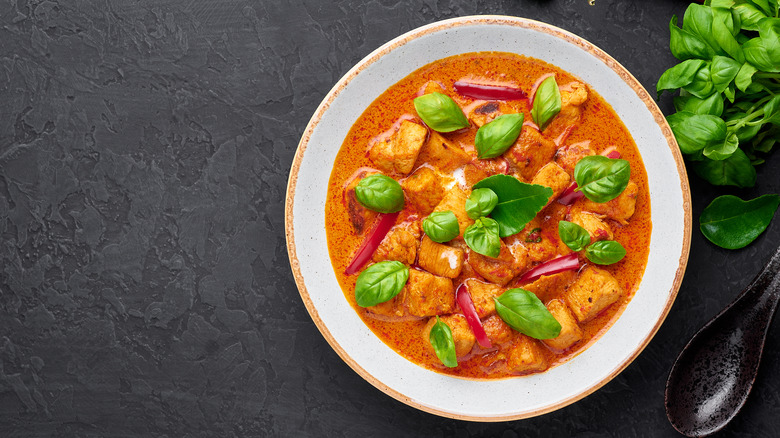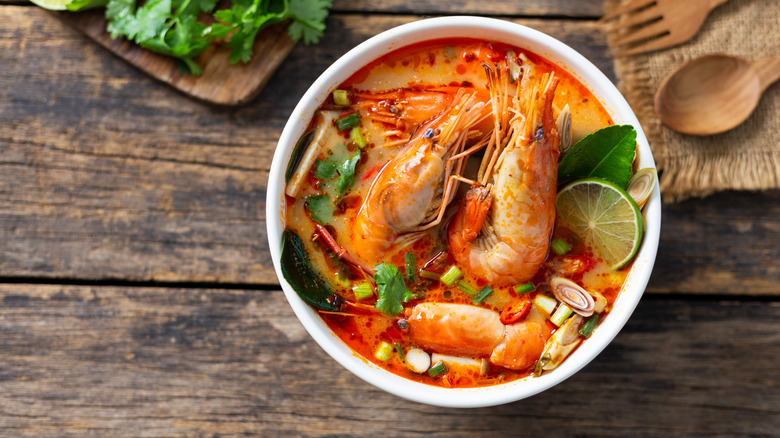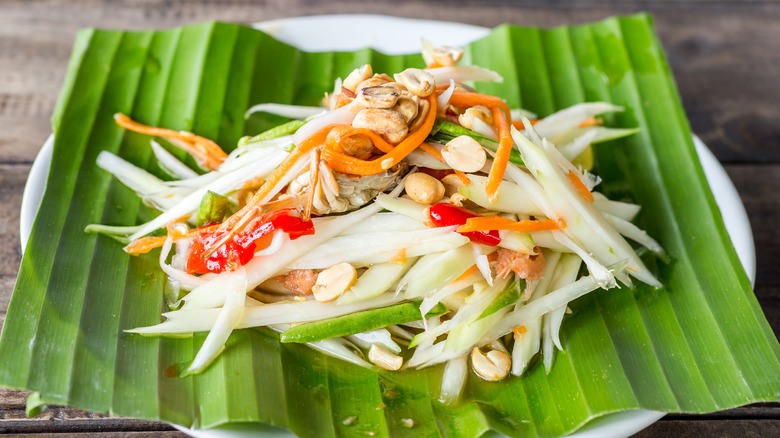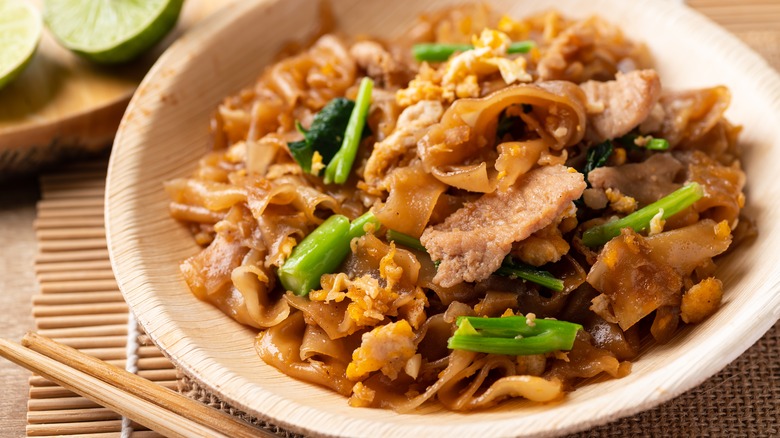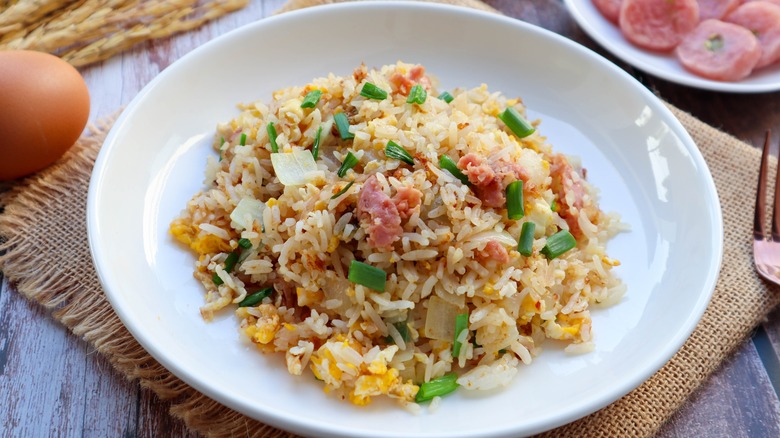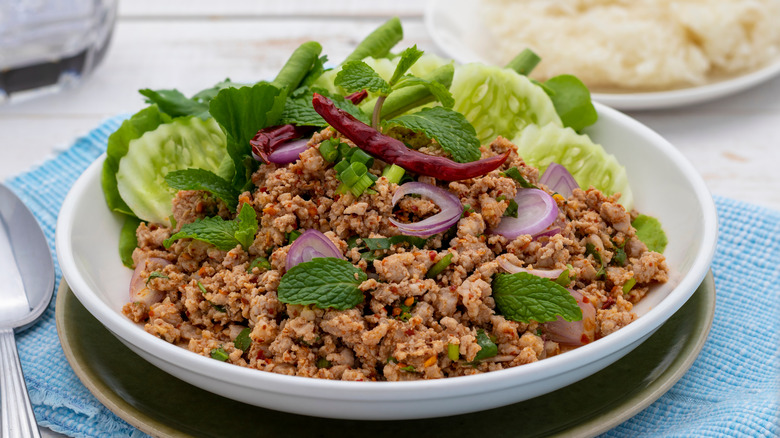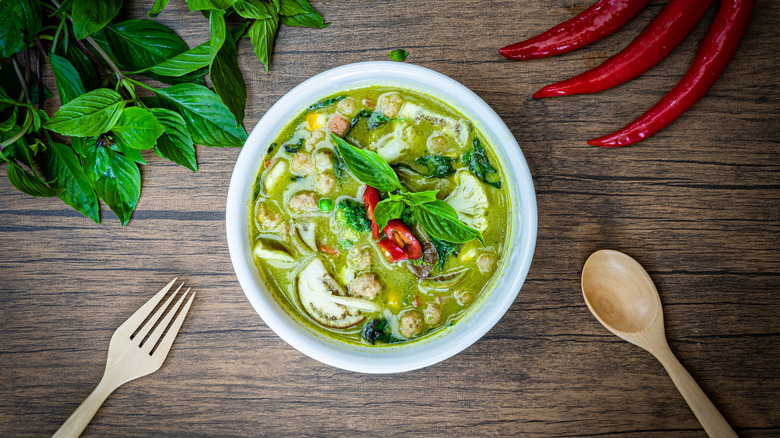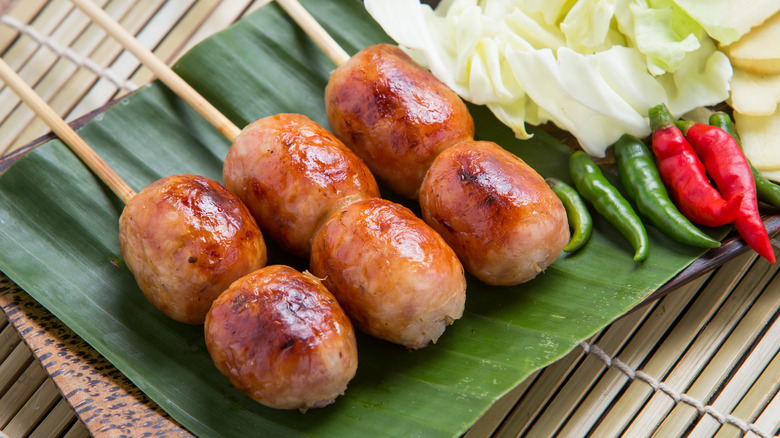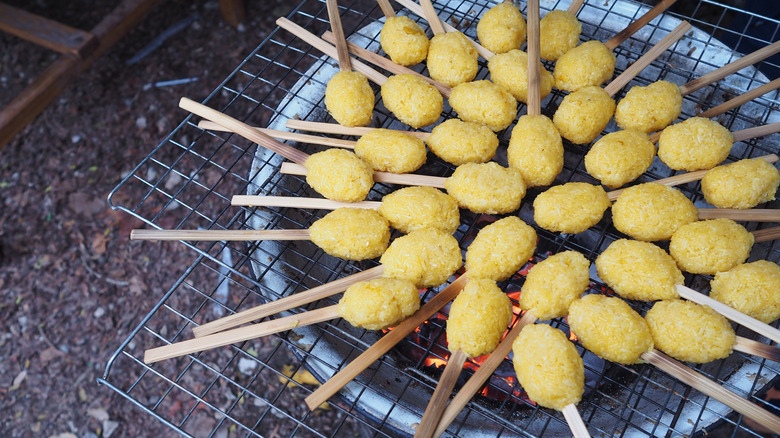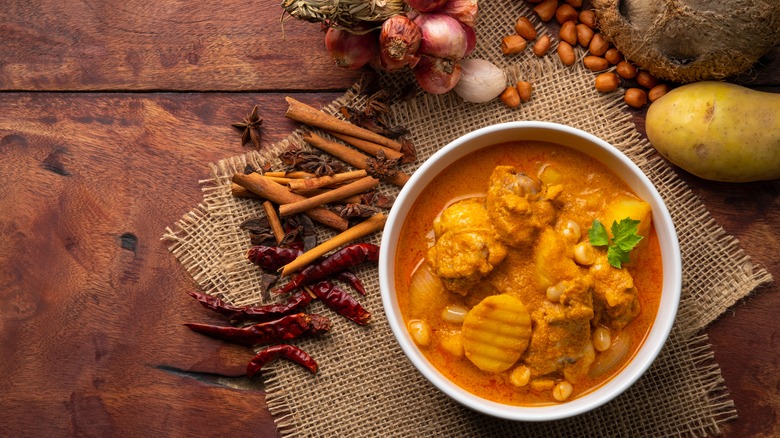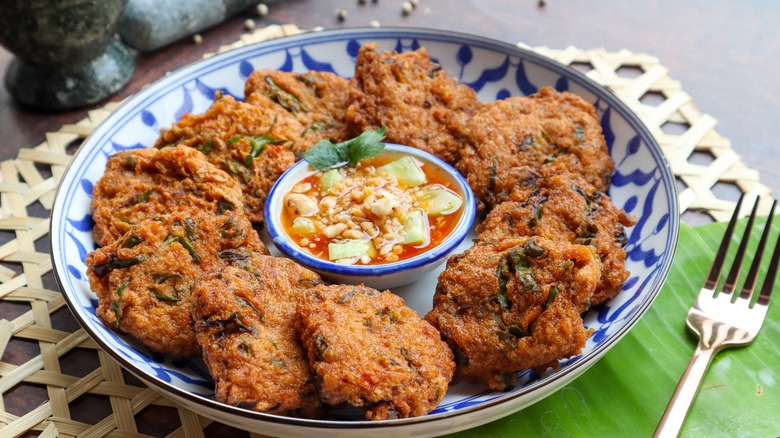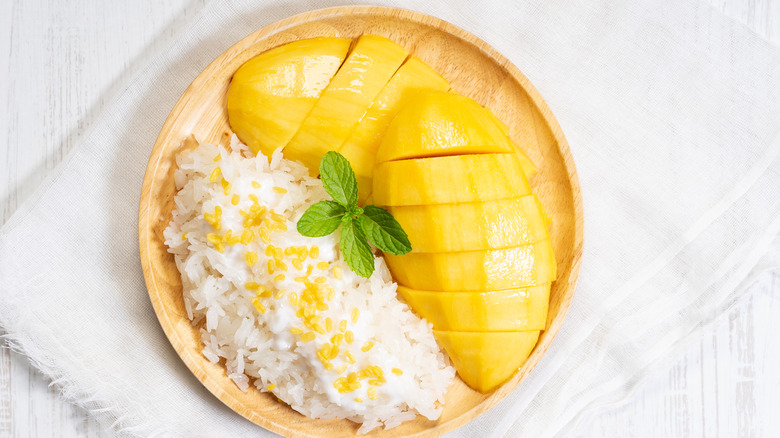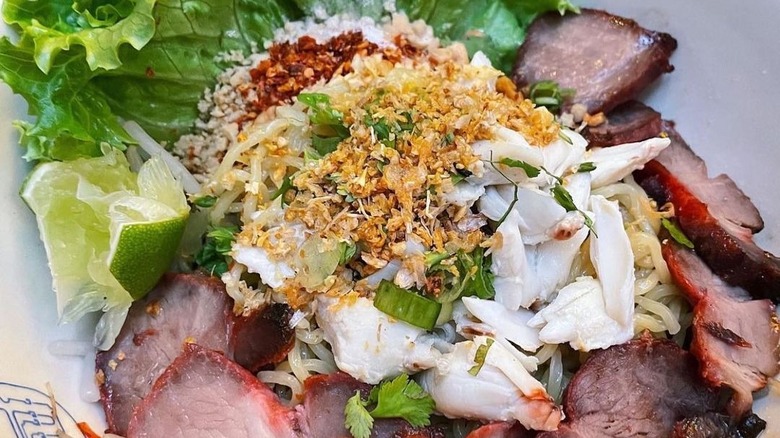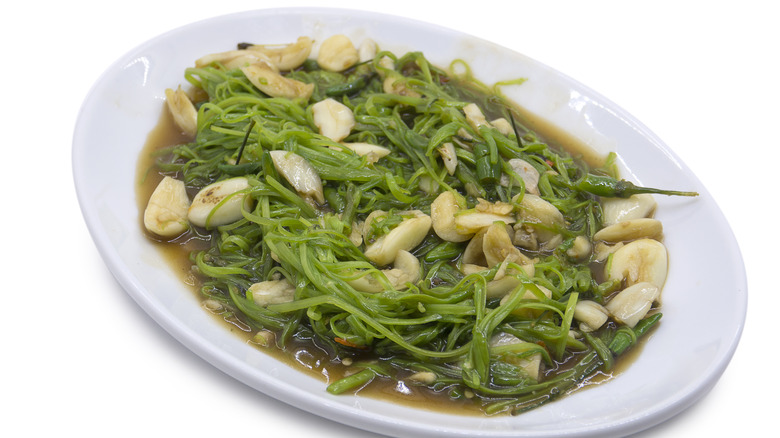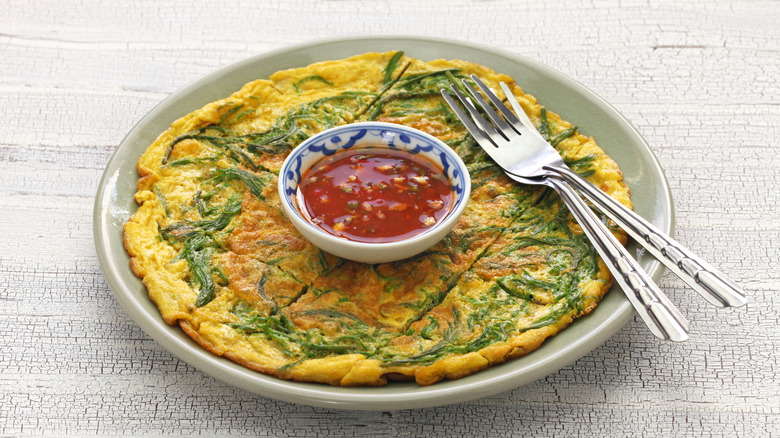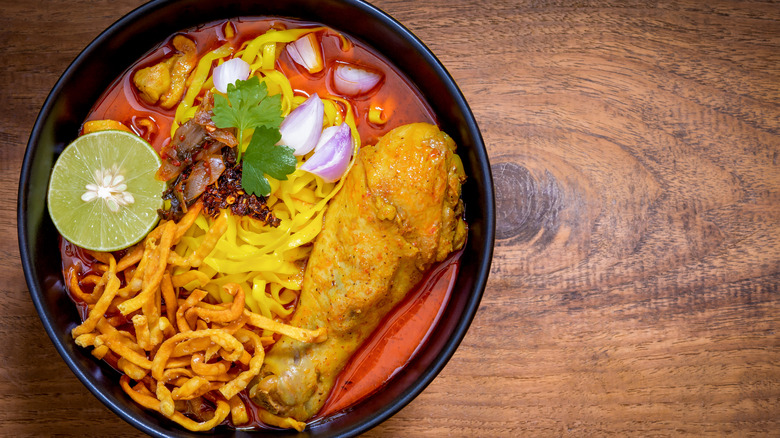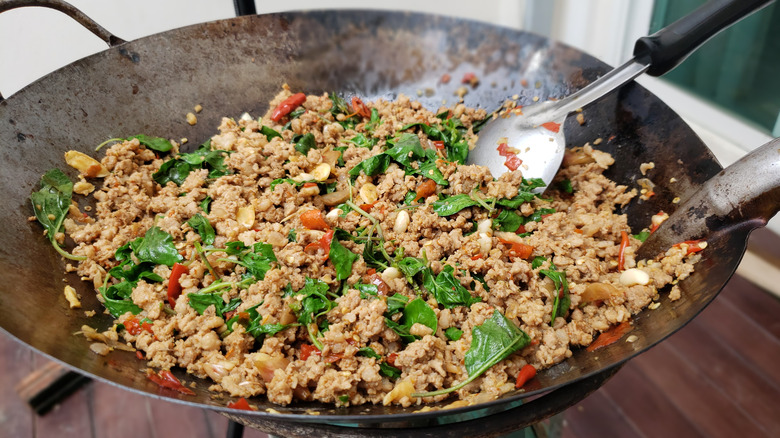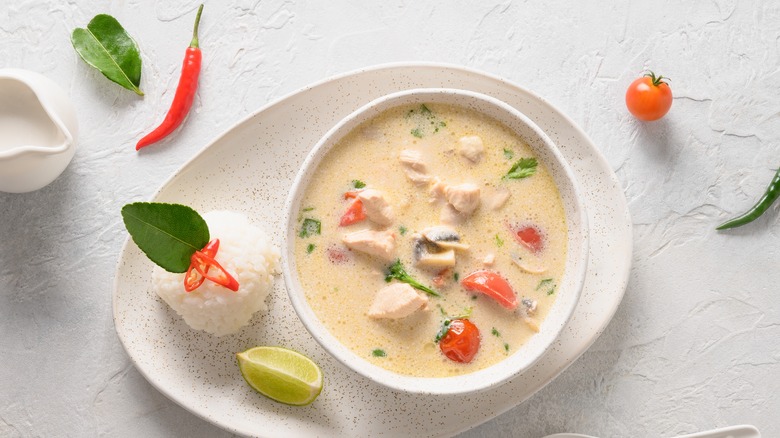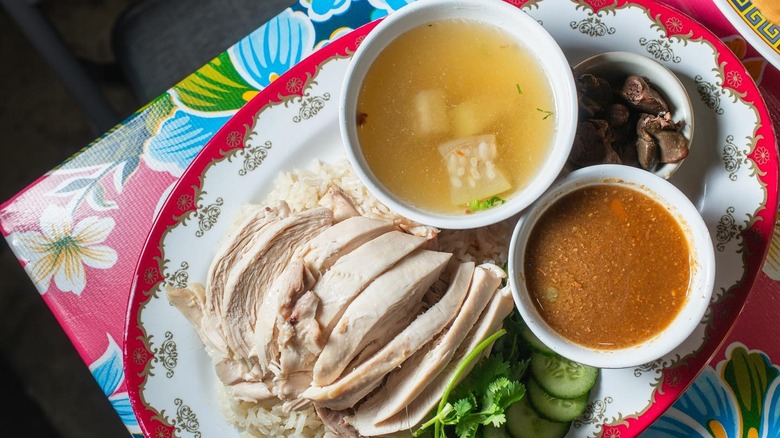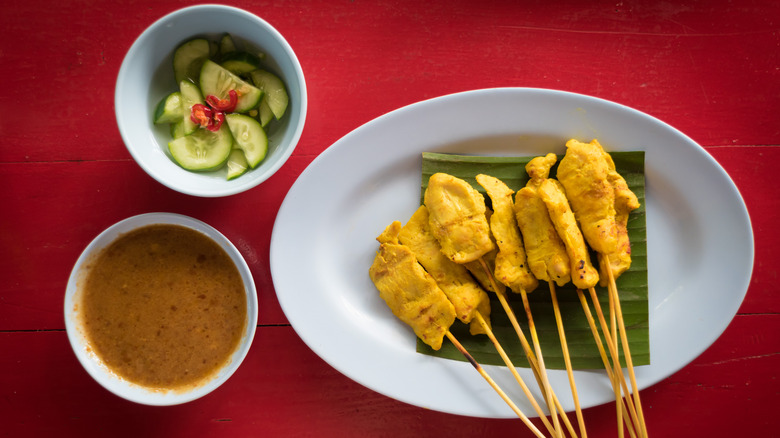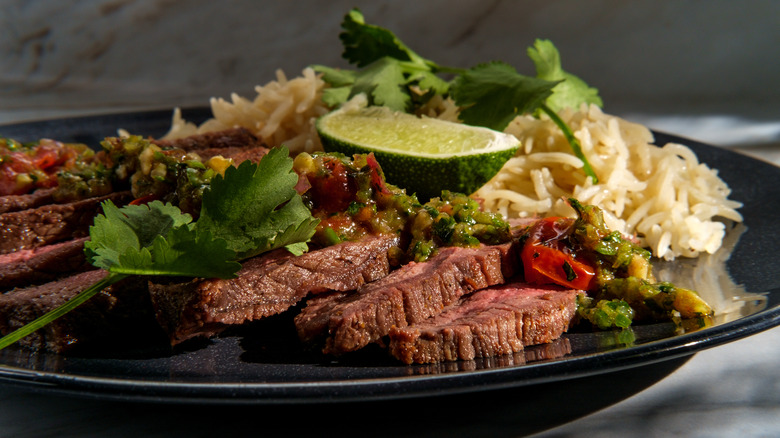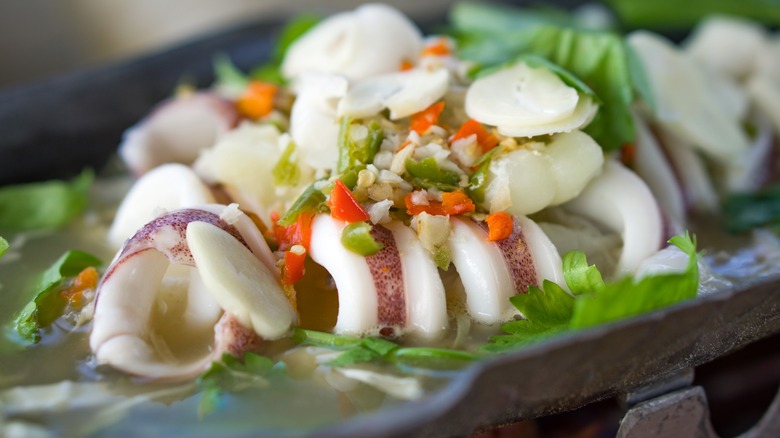23 Traditional Thai Dishes You Should Know About
We may receive a commission on purchases made from links.
When you think about Chinese takeout food, it's usually from the perspective of wondering whether it's authentically Chinese. The answer is no, not really. But that isn't meant to be a diss — American Chinese food is a proud tradition developed by hard-working immigrants.
Thai food in the United States, we're happy to report, is a bit more representative of what you'd find in Thailand. Yes, there are Thai restaurants selling General Tso's chicken and the like, but generally, your local Thai restaurant is serving up traditional Thai dishes. And then there's the question of authenticity. What is authentic Thai food? Well, that depends on your personal perspective. Thai cuisine is a melting pot, with many dishes borrowed from Chinese, Laotian, Burmese, Cambodian, Malaysian, and other cuisines. There's also the curious case of pad Thai, a dish that didn't formally exist until the 1930s.
We recommend you put these issues to the side and focus on all that Thai food has to offer. Those unfamiliar with Thai food may want to get their feet wet with pad Thai or spicy-sweet Panang curry. Those more familiar with the cuisine might want to go on a deeper dive and explore the spicy, fiery foods of the Isan region and Northern Thailand. No matter your experience level, though, there's something for everyone.
1. Pad Thai
When you think of Thai food, you probably envision pad Thai. But the dish has only formally been around for about a century, and there's strong evidence that it didn't even originate in Thailand. The consensus among experts is that pad Thai actually came from China. What's more certain is how pad Thai came to be the official dish of Thailand.
In the early 20th century, nationalism was all the rage, and Siam prime minister Plaek Phibunsongkhram wanted in on the action. From 1939 to 1942, he issued 12 cultural decrees in the name of nationalization. Siam would now be called Thailand. Women should stop wearing the billowy chong kraben and start wearing skirts instead. And pad Thai was to become the national dish. Why? Because of all the things his housekeeper made, this particular noodle dish was Phibunsongkhram's favorite, according to the South China Morning Post. Today, it can be found all over Thailand and in every Thai restaurant around the world.
Despite the dish not exactly having grassroots origins, pad Thai is quick and easy to make with a simple recipe. It's also a very versatile dish. Chicken is one of the more common proteins to go in pad Thai, but you can also add shrimp, pork, tofu, beef, or just about any other protein you can think of.
2. Panang curry
Thailand sits at a sort of culinary crossroads, and one of Thai cuisine's most famous curries is named after an island off the coast of Malaysia — Penang. While there's some debate about whether Panang (or Penang) curry originated in Thailand, there's no debating its popularity.
Panang curry gets its signature flavor from the incorporation of peanuts into red curry paste. Other ingredients in the curry paste include chiles, lemongrass, cumin, and lime leaves. Typically, Panang curry paste uses fewer chiles than red curry paste. The addition of coconut milk makes this curry sweeter and creamier than red curry.
Chicken is the default protein for Panang curry, but most Thai restaurants give you the option of choosing tofu, beef, or seafood. This curry is typically served in a deep plate or shallow bowl with a small bowl of jasmine rice on the side. Although Asian cuisines are commonly associated with chopsticks, most people in Thailand eat their curry with a fork and spoon. In fact, only noodle dishes are typically eaten with chopsticks in Thailand. The proper way to eat Panang curry starts with spreading your rice out on a plate. Then, you scoop individual bites of curry onto a small portion of rice and eat the entire bite in one spoonful.
3. Tom yum
In 2021, the government of Thailand took steps for the soup known as tom yum to be officially recognized by the United Nations as part of the country's cultural heritage. It's a bold but deserving move in support of a classic traditional Thai dish.
Tom yum soup originated in the central parts of Thailand, but it's a ubiquitous dish that can be found in every Thai restaurant worth its salt. Food historians have had difficulty finding written mentions of tom yum soup before the late 19th century. This lack of documentation, experts say, suggests the soup has ancient origins and has been part of the Thai cultural fabric for so long, there was no need to write down a recipe for it.
If you're looking to make this traditional Thai soup at home, there is a great tom yum soup recipe over at Mashed courtesy of recipe developer Catherine Brooks. The recipe features classic Thai ingredients like lime, lemongrass, and palm sugar.
4. Green papaya salad
Most people are drawn to Thai cuisine because of its reputation for hearty, carb-driven dishes. Green papaya salad ("som tum") is an explosion of brightness that couldn't be further from this reputation. Great on its own, green papaya salad is ideal alongside noodle and stir-fry dishes.
While other countries in Southeast Asia like Cambodia and Laos also have a signature green papaya salad, the Thai version is arguably the most approachable, and therefore, the most popular. For example, the Laotian version features a fermented fish paste, which can be more of an acquired taste. Typical ingredients in a traditional Thai papaya salad include green papaya, carrots, long beans, peanuts, lime juice, palm sugar, and fish sauce.
Many modern chefs have put their own spin on this traditional Thai dish, and one of the more notable green papaya salads is from Leah Cohen, owner of Pig & Khao in New York City. Inspired by a papaya salad she had in Vietnam, Cohen's version includes fried taro chips that give the salad a neat textural contrast.
5. Pad see ew
While pad Thai is the most popular Thai noodle dish, its cousin pad see ew is fairly ubiquitous and a favorite of many. Like pad Thai, pad see ew likely has origins in China, not Thailand. Unlike pad Thai, pad see ew is built on wide flat noodles instead of thin wispy ones.
Wide flat noodles might be a defining feature of the dish, but the secret to good pad see ew is in the sauce. This sweet-salty sauce is made with a combination of rice wine vinegar, oyster sauce, fish sauce, and two different kinds of soy sauce.
Many of the best recipes for pad see ew use both dark and light soy sauce. Dark soy sauce — like Kikkoman soy sauce — is the kind most commonly found in your local grocery store or on Amazon. It might not be labeled "dark," but that's what it is. Light soy sauce — such as this bottle from Peal River Bridge — is thinner and lighter in color. However, it has a stronger, saltier taste than dark soy sauce. The combination of these sauces brings depth of flavor without overpowering the rest of the dish.
6. Khao pad
Traditional fried rice dishes are common in many Asian countries and Thailand is no exception. "Khao pad" is the Thai term for fried rice, and it can be found at just about every street vendor and restaurant in Thailand. Ingredients like jasmine rice, Thai basil, cilantro, fish sauce, and Thais chiles differentiate khao pao from other types of fried rice. Beyond that, just about anything is fair game in spicy Thai fried rice.
One popular version of khao pad includes the spicy Thai condiment known as nam prik, which is a combination of fish sauce and ground Thai chiles. Khao pad saporot is another popular version that adds pineapple and meat or seafood. It's also common to find curry sauce, sausages, and all manner of fermented foods in khao pad.
Cooking khao pad is similar to making other types of fried rice. First, it's good to have cooked rice that's a day or two old. Also, you should cook down your meats, aromatics, and vegetables before adding your sauces. After adding your rice and cooking it until hot, you can add final seasonings like lime juice and fresh cilantro.
7. Larb
Also written in English as laab, laap, and larp, larb is a Thai food from the Isan region in the northern part of the country. Heavily influenced by neighboring Laos, the Isan region covers about one-third of Thailand. Food from Isan is known for its fresh, spicy, and salty flavors.
Larb is a spicy meat salad, a quintessential Isan dish, and one of the best Thai foods you probably haven't tried yet. Served as either an appetizer or main course, larb is based on finely chopped and cooked fish or meat, which can include beef, pork, and poultry. The chopped protein is typically flavored with cilantro, Thai basil, mint, lime juice, fish sauce, shallots, toasted rice, and a heavy dose of minced Thai chiles. Most Thai restaurants will ask you for your preferred spice level when you order, and you should know that even the most moderately spiced versions of larb can make you feel like a guest on Hot Ones. The is a raw meat version of larb called koi, but unsanitary preparation practices in Thailand have made koi a public health concern.
8. Green curry
Made with coconut milk, fresh chiles, and curry paste, green curry ("geang keow wan") is one of the most popular culinary exports of Thailand. As with pad Thai, the formal creation of Thai green curry didn't happen until relatively recently. According to National Geographic, the first Thai cookbooks were written in the 1890s, and a recipe for green chili didn't appear until a recipe book that was published in 1926. This is a much different story from massaman curry, which is known to be more than 300 years old.
The relative newness of Thai green curry isn't surprising given the fact that the ingredients to make it weren't available in Thailand until Western colonialism. Chiles were brought to Thailand from South America in the late 1600s by Portuguese traders. While coconuts were used to make desserts for hundreds of years, they weren't used to make savory dishes until interactions with Malay, Persian, and Indian cuisines. Before this, Thai cooks used water to make curries. Furthermore, the use of white pepper, ground cumin, and ground coriander in green curry also suggests a strong Indian influence on green curry.
As with most curries, any recipe for green curry is easily modified, yet very forgiving. For example, many recipes call for fresh cilantro, but in Thailand, cilantro leaves are never used in green curry, according to National Geographic. Nevertheless, many Western versions of green chili paste include cilantro leaves.
9. Isan sausage
One of the most popular foods from the Isan region in Northeastern Thailand is a type of sausage called "sai krok isan." Typically made with pork meat and fat, these sausages go through a brief fermentation period of a few days to give them a signature sourness. This process is sparked by the addition of cooked rice, and some versions include glass noodles. The longer the sausages are allowed to ferment, the sourer they become. In addition to being flavored by microbial activity, these sausages are also typically seasoned with garlic, soy sauce, and black pepper.
These sausages are grilled and then commonly served with raw cabbage, sliced raw ginger, and Thai chiles. While they can be eaten as snacks, Isan sausages are commonly served with sticky rice to make a full meal. They are common throughout Thailand and are commonly served by street vendors throughout the country.
10. Khao gee
In the Isan region, sticky rice is life. Most people from the region either grow up in a family of rice farmers or have worked in the fields. Understandably, this type of rice is a culinary staple. Not only is it prolific in the region, but it's also very portable, easily reheated, filling, and contains more energy than plain white rice. It's also an essential contrast to the spicy, sour, and funky flavors that are common in Thai cuisine.
One popular preparation called "khao gee" involves wrapping sticky rice around skewers in elliptical balls and grilling it. After an initial grilling, the rice balls are basted with a coating of egg. The result is a starchy treat with a range of different textures. In Isan, khao gee is commonly made as a winter comfort food, according to the Michelin Guide.
If you are going to make sticky rice at home, you should know that it takes time. After being rinsed, sticky rice should be soaked for at least two hours — but usually, it's soaked overnight before being cooked. You should also consider making sticky rice in a steamer because it gives the perfect balance between chewy and sticky.
11. Massaman curry
While a lot of Thai dishes take inspiration from neighboring China and Laos, massaman curry is unusual in that its origins appear to be from South Asia and the Middle East. With a name derived from the word for Muslim, massaman curry includes many spices from curries found west of Thailand, like turmeric, clove, nutmeg, and cinnamon. Massaman curry is also distinct for its lack of chiles. It's spicy and fragrant, but fairly mild with respect to heat. When it doesn't incorporate coconut milk, massaman curry is better suited to seafood than other Thai curries that have coconut milk as a defining ingredient. massaman curry is usually made with chicken and potatoes. Given its Islamic roots, this curry isn't typically made with pork.
Massaman curry is often confused with Panang curry because both curries incorporate peanuts. Different curry pastes are the main difference Panang curry and massaman curry. Panang curry starts as a red curry, which is based on red chiles, while massaman uses a turmeric-based, yellow curry paste.
12. Tod mun pla
Thailand is a coastal country and many of its dishes involve fish. Thai fish cakes called "tod mun pla" can be found everywhere in Thailand and are typically sold by street vendors and restaurants. They are easy to make with firm white fish and typically incorporate red curry paste.
The tricky part about making seafood cakes is preventing them from falling apart. A common way to keep crab cakes from falling apart is to chill them before they are cooked, and this technique can also be applied to tod mun pla. After you have formed patties made of ground fish meat, vegetables, seasonings, and bread crumbs, place them in the fridge for one to three hours. Alternatively, you could chill your mixture before forming the patties. This not only helps to keep your fish cakes from falling apart, but it's also easier to handle your mixture. When it comes to forming the patties, take a page out of one celebrity chef's playbook: Ina Garten uses an ice cream scoop to form perfectly even fish cakes.
13. Mango sticky rice
Sticky rice — or glutinous rice — is a staple in Thai cooking and a very specific type of rice. The difference between white rice and sticky rice comes down to chemistry. White rice has two kinds of starch molecules: amylopectin and amylose. Sticky rice almost entirely contains amylopectin. This type of starch breaks apart when exposed to hot water, causing the rice grain to break open and become sticky.
One of the most popular uses of this type of rice is mango sticky rice. Similar to rice pudding, mango sticky rice is the ideal dessert in summer, when mangoes are in season. Other ingredients in a typical mango sticky rice recipe include coconut milk and cinnamon. This dessert goes great with all kinds of food, not just Thai food, and this should be a welcome addition to any backyard barbeque. Perhaps best of all, it takes less than 45 minutes to make.
14. Dry noodle soup
There are a lot of hot days in tropical Thailand, and the last thing you'd probably want on a sweltering day is a bowl of steaming hot soup. But sometimes, a soup is so good you'd do anything to eat it. Enter the Thai tradition of "dry noodle soups." Restaurants and street vendors in the country commonly serve noodle soups with the broth reserved or served on the side. For the uninitiated, so-called dry noodle dishes ("kuai-tiao haeng") somewhat resemble pasta dishes, but without sauce. It is common for people to put condiments on their dry noodles.
A great example of this dish is the dry crab noodle soup ("ba mii pu") at the Thai noodle bar Soothr in New York City. Egg noodles are dressed with thick, sticky black soy sauce and topped with a ring of roasted pork that lines the bowl. A pile of crab meat sits atop the noodles in the middle of the bowl. The dish is garnished with sliced Thai chiles, a lime wedge, and crushed peanuts.
15. Phak boong
Somewhat resembling a morning glory, the vine known as phak boong grows just about everywhere in Thailand. It's also edible and one of the more common vegetables found in traditional Thai cooking. Phak boong used to be a nuisance plant in rice fields, but farmers working the fields began to realize that the vine's tender shoots went well with their typical lunchtime meal of grilled snakehead fish and the spicy condiment nam phrik. Over time, phak boong transitioned from nuisance to cultivar. Many rural Thai families will grow phak boong on bamboo frames and harvest the shoot as needed.
Phak boong is commonly presented as a stir-fry dish with the same name. Tossed in a sizzling wok with fish sauce, oyster sauce, chiles, garlic, and fermented soybean paste, phak boong is quick and easy to make. It works great as a side dish alongside other Thai dishes, but it can also be a complete meal if served with rice.
16. Kai jeow
Kai jeow is often referred to as a Thai-style omelet, but calling this crispy, fluffy egg cloud an omelet would suggest it's a breakfast dish. Thai people eat kai jeow any time of day, and it's usually served atop a bed of rice. It's also served alongside sour and spicy dishes as a kind of palate cleanser. While it's commonly served plain, you can find versions that incorporate different fillings.
If you're looking to make kai jeow, however, it may help to think of it as an omelet after all. If you want to add filings, you should stay away from a few fillings that should never be put in an omelet. Fruits, vegetables, and produce with a lot of moisture, like mushrooms or tomatoes, should be cooked down a bit before being added in. Also, sauces like ketchup or pesto are best as toppings, not fillings. And it's best to stick to one or two fillings. A good omelet — or a good kai jeow in this case — is all about simplicity.
17. Khao soi
The food of Northern Thailand is heavily influenced by its neighbors to the west and east: Myanmar and Laos, respectively. A few years ago, chef Kanlaya Supachana explained to us at a Northern Thai dinner party how the flavors of Myanmar (formerly Burma) find their way into dishes from the region: "We use a lot more herbs in the North. Just in the curry paste for the khao soi we put coriander root, lemongrass, fresh turmeric, and lime leaves."
Typically made with chicken, khao soi is a curry dish that's exemplary of Northern Thai food. In addition to incorporating Burmese spices, khao soi is also notable for having egg noodles with two textures: soft noodles cooked in the broth and crispy fried noodles served atop the curry. Our recipe for khao soi, adapted from Supachana's recipe, includes pickled mustard greens, shallots, lime wedges, cilantro, chile oil, and palm sugar.
18. Pad kra pao moo
Also spelled pad krapow moo, the name of this dish says most of what you need to know: Pad (stir-fry), krapow (Thai holy basil), and moo (pork). Pad kra pao moo is one of Thailand's most popular dishes, given its easy preparation and blend of sweet, salty, and spicy flavors. As the name suggests, it relies heavily on the anise and cinnamon flavors of Thai basil, with fish sauce and sweet and light soy sauces assisting in the heavy lifting.
It's a quick-cooking dish where the garlic and chiles are quickly stir-fried to activate them before adding the pork to the wok. Soy, sugar, fish sauce, and a healthy amount of basil finish the dish. You'll frequently find pad kra pao moo served with jasmine rice, topped with a fried chicken egg, and finished with even more freshly chopped basil.
19. Tom kha gai
Galangal (kha), although similar in appearance to ginger, is earthier, with citrus notes and sharp pine notes than its relative. Those flavor notes, when paired with fresh lime and Makrut lime leaves, provide a cutting, sour-ish contrast to the richness of coconut in this famous soup.
This quick-cooking soup starts with simmering diced dark-meat chicken (gai) in stock flavored with lemongrass, galangal, and makrut lime leaves. Sometimes, cooks use white meat, but dark is the preferred choice for the soup. After cooking the chicken, cooks remove the aromatics from the broth, and the coconut milk goes into the pot to simmer a bit more, along with some fish sauce for umami and saltiness. A little palm sugar adds sweetness and balances the tart/salty flavor, chiles for fruitiness and heat, and mushrooms add earthiness and bulk to the soup. When done cooking, the soup gets some finishing touches of fresh lime juice, cilantro, and scallions. When served as a course, tom kha gai gets a little jasmine rice in the bowl to finish the dish, or the rice goes on the table as a side for a complete meal.
20. Khao man gai
Khao man gai is another popular Thai street food. Sometimes called Hainan chicken, this Chinese-origin dish exists in varying iterations across a broad swath of Southeast Asian countries. In Thailand, it's known as "rice fat chicken." If only it were that simple, as the dish has complex flavors that the modesty of its name.
The chicken is pretty straightforward, as it's poached in stock or water that cooks flavor with cilantro stalks, pandan, and ginger. The resulting broth is used to both cook the rice and to make a soup of gourd or winter melon, cilantro, soy, and scallions. The fatty rice portion of the name comes from cooking rice with chicken fat and sesame oil-browned garlic, which gives the rice a luxurious richness before finishing in the poaching liquid, which lends the flavor of the aromatics from the original cooking. The last component is a vinegary sauce of ginger, soy, fermented yellow bean paste, and chiles.
21. Sate gai
Sate (satay) is one of the more recognizable Thai standards and one of the more frequently shrugged-off ones, at that. It's not because the dish is bad, but simple dishes rely on often ignored details. Stripped down to basics, cooks marinate strips of chicken in coconut cream, sweetened, condensed milk, fish sauce, turmeric, and sugar with a paste of shallots, coriander, cumin, and peanuts.
After marinating, cooks skewer the meat and grill the loaded skewers, sometimes basting them with fatty coconut cream as they cook. Then, they serve the three skewers with a dipping sauce and some vegetable accompaniment. The satay-style sauce can be a sweet and sour chile and shallot sauce or, more commonly in the U.S., a blend of peanut butter, chiles, and lime juice that's sometimes sweetened with honey. The vegetable sides can be a cucumber relish or fresh vegetables like cucumber and green beans. In an interesting twist, renowned Chef Andy Ricker likes to serve Pullman or other thick white bread on the side of his sate at his former restaurant, Pok Pok, in Portland, Oregon.
22. Suea rong hai
A bowl of peanuts or stale cheese puffs loses its luster after seeing Suea Rong Hai recommended as a snack with beer. Also known as Crying Tiger, the dish originated in Northeast Thailand before gaining popularity across the country. As a name, Crying Tiger has a murky background based on lore. One version says the dish is made from meat so tough that a tiger will cry because it can't eat it. Another says the chiles in the dish bring tears to said tiger's eyes. Whatever the truth of its origins is, suea rong hai is a sweet, tart, salty, and spicy snack.
The dish frequently calls for brisket or flank steak, which marinates in sugar and soy or oyster sauce before grilling. After grilling and thin-slicing the meat, cooks serve it with a tamarind-heavy chile sauce that balances sweetness, tartness, and heat for dipping. An obligatory pile of sticky rice makes the perfect accompaniment.
23. Yum pla muk
This squid salad hits the essential flavor elements that embody Thai cooking: sweet, salty, tart, and spicy. This simple salad consists of chilled, plainly quick-cooked squid, either stir-fried, grilled, or poached. The quick cooking ensures the squid doesn't get tough and rubbery. After cooking, the squid is treated with lime, fish sauce, chiles, garlic, and sugar. Some versions augment the dressing or marinade with lemongrass and makrut lime for an added citrusy note.
The salad portion is also variable, but lettuce, usually bibb or little gem, or sometimes something crunchier, like romaine, is a constant. In some variations, cooks add mint and cilantro leaves for a floral kick. Scallions are a frequent addition to the salad, and cucumbers often make an appearance. Less frequently but worth noting, cherry tomatoes or pieces of whole, larger tomatoes make it onto the plate.
